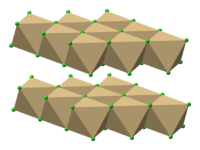Cadmium chloride
| Cadmium chloride | |
|---|---|
 | |
 | |
 | |
| Identifiers | |
| CAS number | 10108-64-2 |
| PubChem | 24947 |
| ChemSpider | 23035 |
| UNII | J6K4F9V3BA |
| EC number | 233-296-7 |
| UN number | 2570 |
| ChEBI | CHEBI:35456 |
| RTECS number | EV0175000 |
| Jmol-3D images | {{#if:[Cd+2].[Cl-].[Cl-]|Image 1 |
| |
| |
| Properties | |
| Molecular formula | CdCl2 |
| Molar mass | 183.32 g/mol |
| Appearance | white solid, hygroscopic |
| Odor | odorless |
| Density | 4.047 g/cm3 (anhydrous) 3.33 g/cm3 (pentahydrate) |
| Melting point | 564 °C; 1,047 °F; 837 K |
| Boiling point | 967 °C; 1,773 °F; 1,240 K |
| Solubility in water | 100 g/100 mL (0 °C) 135 g/100 mL (20 °C) 147 g/100 mL (100 °C) |
| Solubility | soluble in acetone, alcohol negligible in ether |
| Structure | |
| Crystal structure | Rhombohedral, hr9, SpaceGroup = R-3m, No. 166 |
| Hazards | |
| MSDS | External MSDS |
| EU Index | 048-008-00-3 |
| EU classification | Carc. Cat. 2 Muta. Cat. 2 Repr. Cat. 2 Highly toxic (T+) Dangerous for the environment (N) |
| R-phrases | R45, R46, R60, R61, R25, R26, R48/23/25, R50/53 |
| S-phrases | S53, S45, S60, S61 |
| NFPA 704 |
 1
3
0
|
| Related compounds | |
| Other anions | Cadmium fluoride Cadmium bromide Cadmium iodide |
| Other cations | Zinc chloride Mercury(II) chloride Calcium chloride |
| Except where noted otherwise, data are given for materials in their standard state (at 25 °C (77 °F), 100 kPa) | |
| Infobox references | |
Cadmium chloride is a white crystalline compound of cadmium and chlorine, with the formula CdCl2. It is a hygroscopic solid that is highly soluble in water and slightly soluble in alcohol. Although it is considered to be ionic, it has considerable covalent character to its bonding. The crystal structure of cadmium chloride (described below), composed of two-dimensional layers of ions, is a reference for describing other crystal structures. Also known are CdCl2.H2O and CdCl2.5H2O.[1]
Structure
Cadmium chloride forms crystals with rhombohedral symmetry. Cadmium iodide, CdI2, has a very similar crystal structure to CdCl2. The individual layers in the two structures are identical, but in CdCl2 the chloride ions are arranged in a CCP lattice, whereas in CdI2 the iodide ions are arranged in an HCP lattice.[2][3]
Chemical properties
Cadmium chloride dissolves well in water and other polar solvents. In water, its high solubility is due in part to formation of complex ions such as [CdCl4]2−. Because of this behavior, CdCl2 is a mild Lewis acid).[2]
- CdCl2 + 2 Cl− → [CdCl4]2−
With large cations, it is possible to isolate the trigonal bipyramidal [CdCl5]3− ion.[4]
Preparation
Anhydrous cadmium chloride can be prepared by the action of anhydrous chlorine or hydrogen chloride gas on heated cadmium metal.
- Cd + 2 HCl → CdCl2 + H2
Hydrochloric acid may be used to make hydrated CdCl2 from the metal, or from cadmium oxide or cadmium carbonate.
Uses
Cadmium chloride is used for the preparation of cadmium sulfide, used as "Cadmium Yellow", a brilliant-yellow stable inorganic pigment.
- CdCl
2 + H
2S → CdS + 2 HCl
In the laboratory, anhydrous CdCl2 can be used for the preparation of organocadmium compounds of the type R2Cd, where R is an aryl or a primary alkyl. These were once used in the synthesis of ketones from acyl chlorides:[5]
- CdCl
2 + 2 RMgX → R
2Cd + MgCl
2 + MgX
2
- R
2Cd + R'COCl → R'COR + CdCl
2
Such reagents have largely been supplanted by organocopper compounds, which are much less toxic.
Cadmium chloride is also used for photocopying, dyeing and electroplating.
References
- ↑ Lide, David R. (1998), Handbook of Chemistry and Physics (87 ed.), Boca Raton, FL: CRC Press, pp. 4–67; 1363, ISBN 0-8493-0594-2
- ↑ 2.0 2.1 N. N. Greenwood, A. Earnshaw, Chemistry of the Elements, 2nd ed., Butterworth-Heinemann, Oxford, UK, 1997.
- ↑ A. F. Wells, Structural Inorganic Chemistry, 5th ed., Oxford University Press, Oxford, UK, 1984.
- ↑ D. Nicholls, Complexes and First-Row Transition Elements, Macmillan Press, London, 1973.
- ↑ J. March, Advanced Organic Chemistry, 4th ed., p. 723, Wiley, New York, 1992.
External links
- International Chemical Safety Card 0116
- IARC Monograph "Cadmium and Cadmium Compounds"
- National Pollutant Inventory - Cadmium and compounds
| Wikimedia Commons has media related to Cadmium chloride. |
| ||||||||